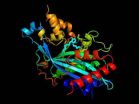(Press-News.org) Regular use of fluoride-containing toothpaste and mouthwash has long been known to strengthen the enamel on teeth. But new research by Howard Hughes Medical Institute (HHMI) scientists finds that fluoride also has dramatic effects on bacteria inside the mouth -- including those that form plaque and can cause cavities.
HHMI researcher Ronald Breaker of Yale University has discovered the cellular chain of events that occurs inside a bacterium after it encounters fluoride in its environment. His team's findings reveal that many bacteria try to fend off fluoride – which the organisms treat as a toxic substance – by throwing it out. The presence of such a transport system indicates that fluoride itself has antimicrobial properties, Breaker said. The findings are published online in Science Express on December 22, 2011.
Breaker's lab studies non-coding RNA, stretches of genetic material that play regulatory roles in the cell instead of coding for proteins. Using different computer algorithms, he and his colleagues analyze the genomes of organisms to identify signature sequences in genetic material that likely indicate the presence of noncoding RNA. Among the types of non-coding RNAs they find are regulatory molecules called riboswitches. Normally, the role of a riboswitch is easy to deduce: Riboswitches are attached to the genes that they regulate. If the gene is needed to produce a certain compound, the riboswitch is usually sensitive to that compound, so when its level increases or decreases in the cell, the riboswitch can cause more or less to be made. Aside from their interest in the biology of riboswitches, Breaker's group is studying these genetic switches because they could represent new drug targets and might be used to control the activity of genes inserted into cells as gene therapies.
In a recent set of experiments, Breaker's team identified a new riboswitch that was attached to a handful of genes with vague or unknown functions. They were stumped. "We knew we had a riboswitch but we didn't know what it bound," says Breaker. "And we were very intrigued because it was one of the only non-coding RNAs we've ever found that's present in both bacteria and archaea. That suggests that it has ancient origins and an important role in the cell," he notes.
So Breaker and his colleagues put the RNA in a test tube and began to mix in different chemicals, observing whether or not they bound to the riboswitch. They worked through a long list of more common chemicals before they stumbled on fluoride. The addition of fluoride was an accident -- fluoride was a contaminant in a sample of a different chemical they were testing.
Once Breaker's group found that the riboswitch bound to fluoride, they were able to show that the genes controlled by the riboswitch are those that help the cell fight the toxicity of fluoride. Fluoride, a negatively charged ion, binds aggressively to some metabolites and essential enzymes. If fluoride floods a cell, it can quickly shut down cellular processes. The fluoride-sensing riboswitch, Breaker's team discovered, turns on a gene coding for ion channels that transport fluoride back out of the cell.
"This riboswitch is detecting fluoride buildup in the cell and turning on genes to help overcome that buildup," says Breaker. Whether or not the riboswitch is successful, and fast enough, determines whether a bacterium can fight the effects of fluoride.
"Our data not only help explain how cells fight the toxicity of fluoride, but it also gives us a sense of how we might be able to enhance the antimicrobial properties of fluoride," says Breaker. "In the future we might be able to use this knowledge to make fluoride even more toxic to bacteria."
Blocking the fluoride channel, for example, makes cells 200 times more sensitive to fluoride, the researchers showed. Finding other ways to enhance fluoride's effects—by inactivating the riboswitch or shutting off other downstream genes—could make fluoride an even better antimicrobial agent.
### END
Bacteria battle against toxic fluoride
2011-12-23
ELSE PRESS RELEASES FROM THIS DATE:
Second Annual Holiday Fashion Show Benefit in New York City
2011-12-23
Long Island Exchange columnist Cognac Wellerlane interviews celebrities during a benefit for kidney transplant awareness.
On Tuesday December 6th an organization called the Flood Sisters hosted an annual Holiday Fashion Show Benefit to support their national kidney foundation. The organization, started by three sisters, is designed to support those willing to donate kidneys as well as those awaiting transplants. They believe that no one should have to suffer through painful treatments while waiting for an expendable organ.
The event was held at the Scandinavia House ...
Severe congenital disorder successfully treated in a mouse model for the first time
2011-12-23
Using a mouse model, Heidelberg University Hospital researchers have for the first time successfully treated a severe congenital disorder in which sugar metabolism is disturbed. The team headed by Prof. Christian Körner, group leader at the Center for Child and Adolescent Medicine, demonstrated that if female mice are given mannose with their drinking water prior to mating and during pregnancy, their offspring will develop normally even if they carry the genetic mutation for the congenital disorder. The team's outstanding work will contribute to better understanding of ...
Boxer Puts a Price on TV2
2011-12-23
At Boxer, we have decided to include TV2 in each of our four TV-packages, so our customers can keep viewing the channel. And on top of this, we are also making Danish TV-history by making it possible for our customers to purchase the channel (in Danish the term is Tv kanaler) separately. For the first time ever, our customers can choose to pay for a single channel without purchasing a full TV-package.
Here are the prices for TV2 purchased separately:
-19 kr./monthly subscription
-199 kr./annual card fee (primarily running and maintenance costs). The fee makes ...
When the mountains call . . .
2011-12-23
When the Mountains Call . . .
. . . don't climb too fast! Lack of acclimatization and excessively rapid ascent are the main risk factors for acute mountain sickness, as Kai Schommer and Peter Bärtsch explain in this issue of Deutsches Ärzteblatt International (Dtsch Arztebl Int 2011; 108 [49]: 839-48).
More and more tourists are climbing up mountains that are 5000 to almost 7000 meters high, such as Kilimanjaro, without any prior experience at high altitudes. The low oxygen content in the air can cause altitude sicknesses of various kinds.
For example, sudden vomiting ...
Umbria Jazz Winter Festival Returns to Orvieto, Italy
2011-12-23
Most of the concerts will be held at the Arena Santa Giuliana on either the main stage or restaurant stage. Other venues include the Teatro Pavone and the Giardini Carducci Conad Stage and restaurant. This year's theme emphasizes the Latin sounds of jazz, delivered by international and Italian jazz and gospel soloists and groups. Among the many featured performers this year are Stan Tracy, Michel Camilo, the Gonzalo Rubalcaba Trio, Chano Dominguez, Fabrizio Bosso, The Harlem Jubilee Singers and la Lydian Sound Orchestra.
Travel to the Umbria Jazz Winter Festival from ...
Journal of Clinical Virology assembles papers on HIV diagnostic testing algorithms
2011-12-23
London, December 22, 2011 – Elsevier's Journal of Clinical Virology in collaboration with the US Centers for Disease Control and Prevention (CDC) today announced the publication of a special supplement entitled 'Update on HIV Diagnostic Testing Algorithms'. This timely supplement contains articles which summarize studies since the 2010 US HIV Diagnostics Conference validating the proposed new US HIV diagnostic testing algorithm. In addition, review articles and original research related to the topic of HIV diagnosis and viral load monitoring are included.
Dr. Bernard ...
Virgin olive oil & fish fatty acids help prevent acute pancreatitis
2011-12-23
The researchers evaluated the role of Mediterranean diet ingredients in the prevention and mitigation of cell damage.
Oleic acid and hydroxytyrosol –present in a particularly high concentration in virgin olive oil– and n-3 polyunsaturated fatty acids –found in fish– affect the cellular mechanisms involved in the development of acute pancreatitis, a disease of oxidative-inflammatory etiology. Therefore, oleic acid and hydroxytyrosol can be considered potential functional ingredients, as they may prevent or mitigate this disease.
Such was the conclusion drawn in a study ...
High genetic diversity in an ancient Hawaiian clone
2011-12-23
The entire Hawaiian population of the peat moss Sphagnum palustre appears to be a clone that has been in existence for some 50,000 years researchers have discovered. The study is published in New Phytologist.
Among the most long-lived of organisms, every plant of the Hawaiian population appears to have been produced by vegetative rather than sexual propagation and can be traced back to a single parent.
Surprisingly, the genetic diversity of the Hawaiian clone is comparable to that detected in populations of S. palustre that do propagate sexually and occur across vaster ...
Harvard physicists demonstrate a new cooling technique for quantum gases
2011-12-23
Physicists at Harvard University have realized a new way to cool synthetic materials by employing a quantum algorithm to remove excess energy. The research, published this week in the journal Nature, is the first application of such an "algorithmic cooling" technique to ultra-cold atomic gases, opening new possibilities from materials science to quantum computation.
"Ultracold atoms are the coldest objects in the known universe," explains senior author Markus Greiner, associate professor of Physics at Harvard. "Their temperature is only a billionth of a degree above absolute ...
Fish oil may hold key to leukemia cure
2011-12-23
A compound produced from fish oil that appears to target leukemia stem cells could lead to a cure for the disease, according to Penn State researchers.
The compound -- delta-12-protaglandin J3, or D12-PGJ3 -- targeted and killed the stem cells of chronic myelogenous leukemia, or CML, in mice, said Sandeep Prabhu, associate professor of immunology and molecular toxicology in the Department of Veterinary and Medical Sciences. The compound is produced from EPA -- Eicosapentaenoic Acid -- an Omega-3 fatty acid found in fish and in fish oil, he said.
"Research in the past ...

